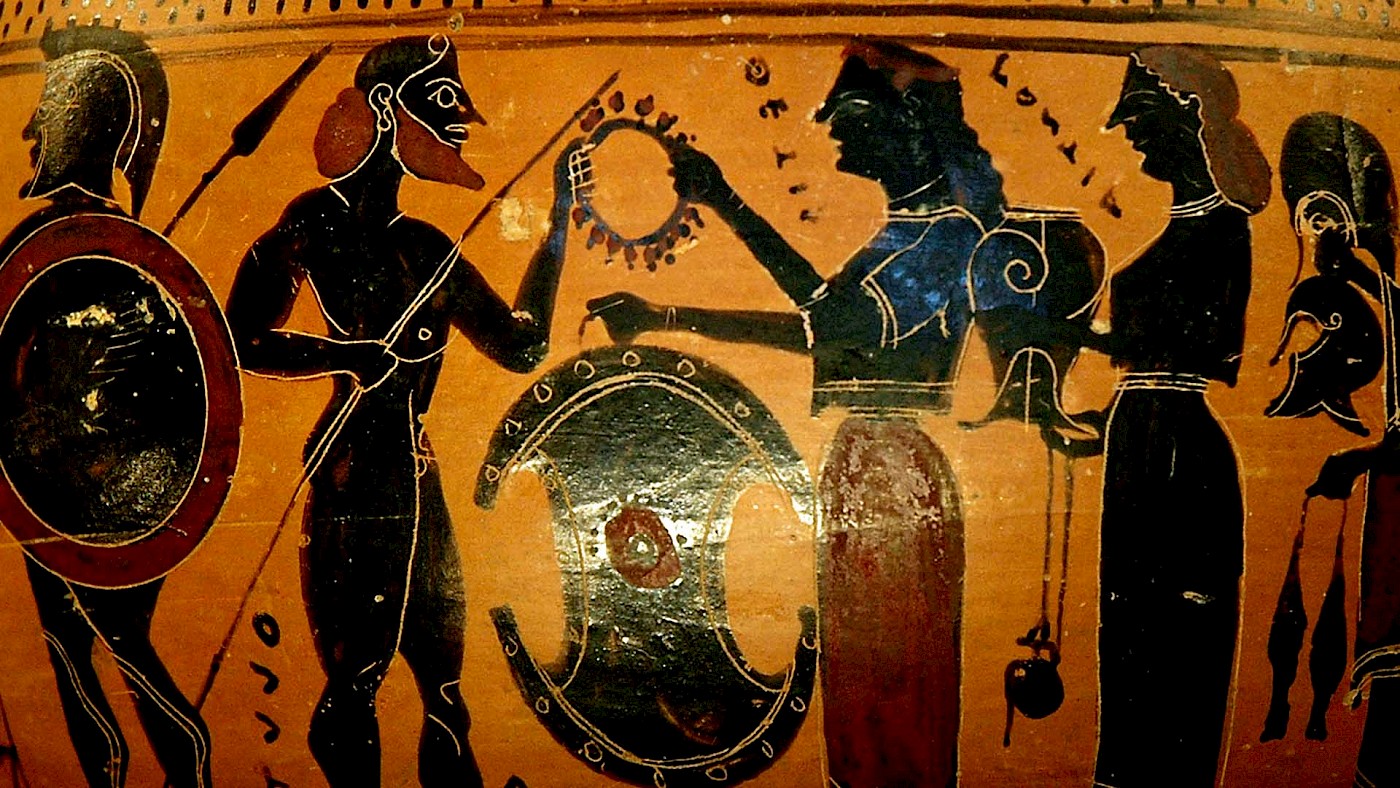When Achilles gets a new shield in the Iliad, it’s described in minute detail in book 18, lines 478–608. Patroclus had earlier confronted the Trojans wearing Achilles’ armour. After he was killed, Hector stripped him of Achilles’ equipment and wore it himself.
Achilles needed new armour, and so his mother, the sea-nymph Thetis, went to Hephaestus, the smith-god of the Olympians, and asked him to fashion Achilles a new suit of armour. Homer tells us (Iliad 478–482, as per the Chicago Homer):
First of all he forged a shield that was huge and heavy,
elaborating it about, and threw around it a shining
triple rim that glittered, and the shield strap was cast of silver.
There were five folds composing the shield itself, and upon it,
he elaborated many things in his skill and craftsmanship.
The description makes clear that the shield was round. Hephaestus adds figurative decorations: he modells the world, the sky, and the seas, the sun, the moon, and all the stars and constellations (ll. 483–489). Having set the scene, he adds two cities: one a city under siege and the other a city in times of peace.
A tale of two cities
In the latter city, a marriage and festivals are shown to take place, with people dancing and making music. But even in this peaceful city, there is conflict. In the place of assembly, the agora, “a quarrel had arisen, and two men were disputing over the blood price for a man who had been killed. One man promised full restitution in a public statement, but the other refused and would accept nothing” (ll. 18.497–500).
There is actually some debate about the proper translation of these few lines (which I won’t go into here), but the contrast is clear: in times of peace, killing is not allowed and disputes are taken to court.
As we see elsewhere in the Iliad, a public assembly of any sort always draws a crowd, and in this case, too, the people assembled proclaim loudly their support for one side or the other, while heralds try to keep them in check and the wise elders of the city sit on benches and confer with one another. In true Homeric fashion, the two men have amassed a pile of gold, to be awarded to the “judge who in this case spoke the straightest opinion” (l. 508).
The other city on the shield is under siege by a hostile army (the Greek suggests two armies, duo stratoi, which has caused some confusion). The besiegers are currently in assembly. Opinion among them is divided: should they try to storm and sack the city or should they accept a bribe from the besieged amounting to half of all the valuables in the city (cf. Iliad 22.111–121)?
Meanwhile, the armed men of the city abandon their walls to prepare an ambush near a river. Their wives, children, and elderly men observe from the city walls in a manner evoking similar descriptions elsewhere in the Iliad. This army is led by both Ares and Athena, depicted larger than the mortal men around them (ll. 514–519).
The army prepares an ambush near a watering place for animals. They set up scouts and when they see shepherds appear with their flocks, they attack them (presumably as a way of acquiring supplies). The besieging army, still lost in debate about what to do, hears the uproar and rushes towards the river. There, fierce fighting breaks out (ll. 533–537):
These stood their ground and fought a battle by the banks of the river,
and they were making casts at each other with their spears bronze-headed;
and Eris was there with Confusion among them, and Death (Ker) the destructive;
she was holding a live man with a new wound, and another
one unhurt, and dragged a dead man by the feet through the carnage.
The fighting is fierce and bloody. Characteristic for Homeric combat, some of the fighting focuses around the bodies of fallen warriors, whom their comrades want to secure but the enemy want to despoil (l. 540). Another characteristic is that the focus is very much on the ambush (lochos) rather than a “pure” pitched battle: Homeric heroes had no qualms about how they went about waging war; the only thing that mattered was victory!
Farming and violence
The remainder of the description focuses on agriculture. Agriculture was central to all pre-industrial societies, and it is something that we, with our modern way of life, should always try to keep in mind. Homer describes how Hephaestus adds fertile farmland, worked by many labourers. He also included the temenos of a king (l. 550), a piece of land ostensibly given to the ruler by his people, with men harvesting. Under a tree, heralds have slaughtered an ox and prepare a feast (ll. 558–559). The god also includes a vineyard (l. 561), with people working to the sound of music, and also includes a herd of oxen (l. 573).
And here, Homer again adds conflict to an otherwise peaceful scene: two fierce lions have managed to capture one of the oxen. The poet says that “with loud lowings [he] was dragged away” (ll. 580–581), pursued by young men and dogs. The lions open up the ox and “gulped the black blood and the inward guts” (l. 583). A gruesome death, to be sure, and one that contrasts greatly with the idyllic scene of fruit-picking girls and youths only a few lines earlier, and the next scene of young men and girls dancing (ll. 590–606)!
In Homer’s world, no place is safe from conflict. Death, or the threat of death, always seems to hover over life.
